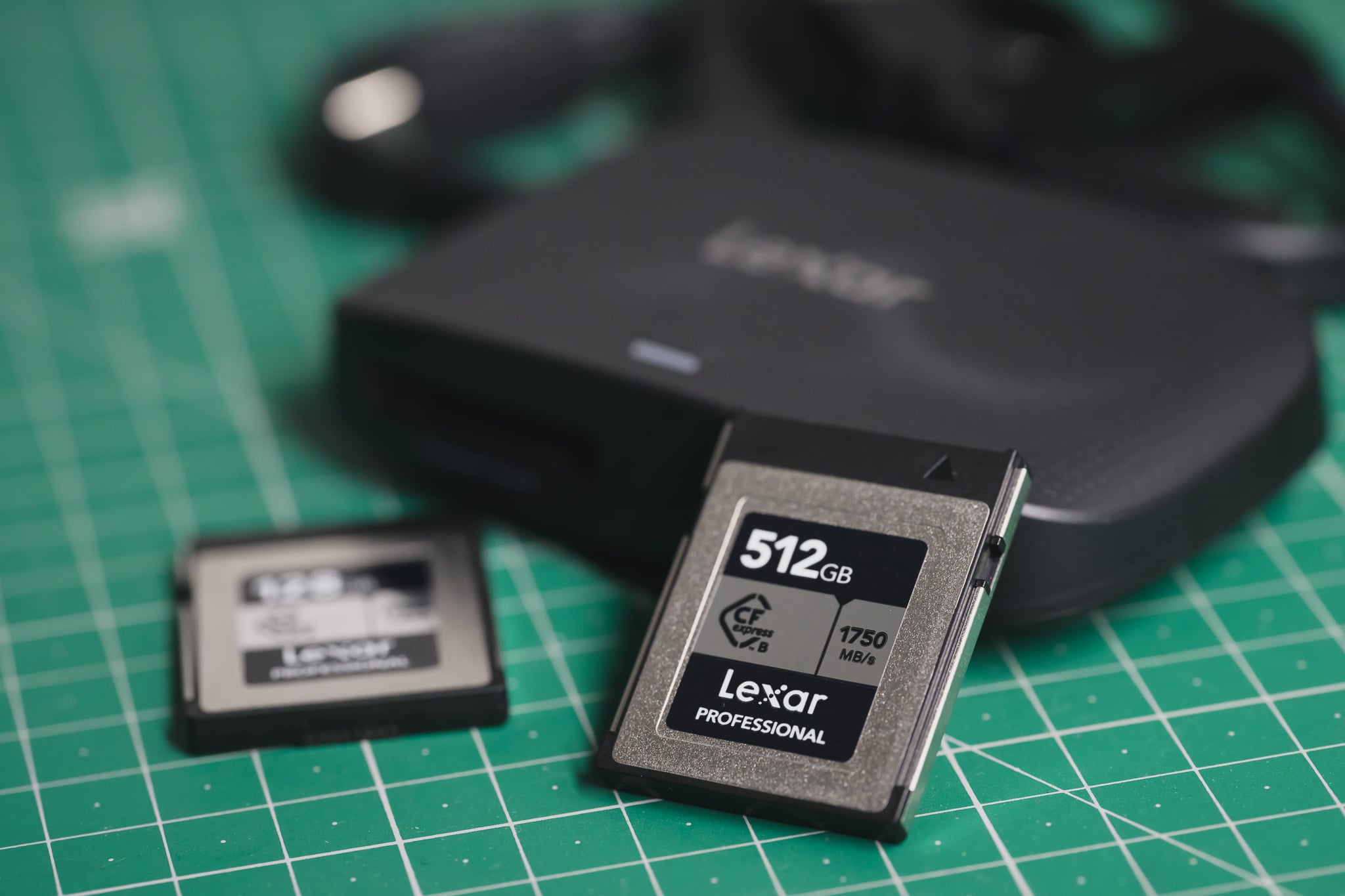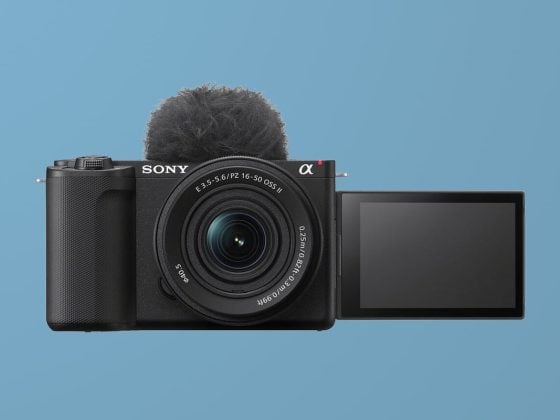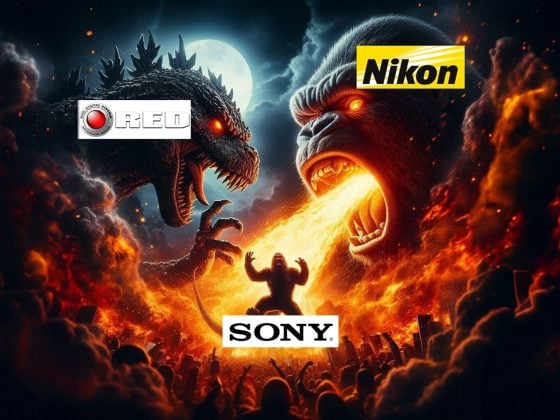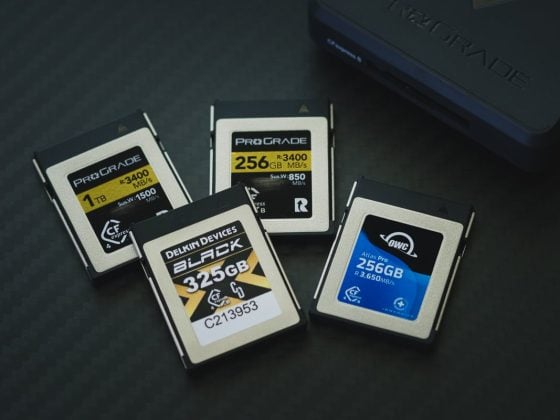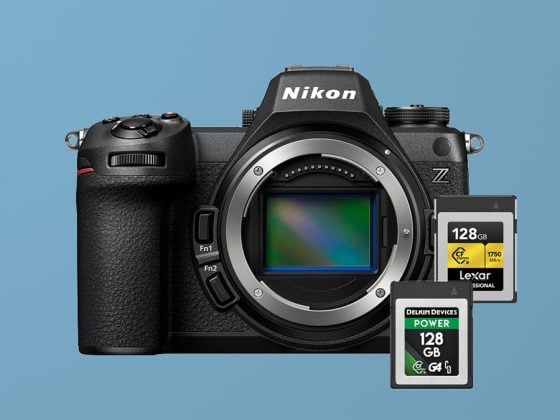The latest CFexpress Type-B memory cards are some of the fastest and most robust types of media you can use for your cameras today. But just how fast are they?
This guide will look at the different performance metrics of the various brands of memory cards.
CFexpress Type B Memory Benchmarks
Testing Method
For these benchmarks, I tested all the cards using a PC with USB 3.2 gen 2×2, which gives 20Gbps speed, and the Angelbird 20Gbps reader. This also ran a lot of cards slightly faster than when I tested everything with Thunderbolt 3 on the MacBook Pro using the OWC reader.
You should pay attention to the Sustain column, which shows the card’s performance after thermal throttling and after its cache is exhausted. Many cards use a faster flash as a short cache to give you their rated speeds. But often, this cache can be very small. I tested using 4GB file sizes, which is about all you would ever shoot in a single burst for the initial USB speeds. Then I check the sustained speeds where I write 64GB files three times to exhaust any cache the cards might have and to engage thermal throttling.
CFexpress Type B Memory cards can use a TLC, MLC or 3D NAND flash but can use an SLC cache.
The software used was the AJA System Test for Windows 11. Resolution: 5120×2700 5k Red / Test File Size: 4GB / Codec Type 16bit RGBA, Single File.
Click the plus button to see rated read and write speeds and rated sustained speeds. Not all brands of cards advertise their rated sustained speeds, although they should all write them on their cards as Prograde now does since that’s the only spec that matters for videography.
| CFxB Memory Cards | Reviews | Rated Write | Rated Read | Sustained | Tested Write | Tested Read | Tested Sustain | |||
|---|---|---|---|---|---|---|---|---|---|---|
| CFExpress Type-B | Hide | |||||||||
| Lexar Diamond 128/256/512GB | Lexar Diamond CFeB Review | CFx-B | 1700 | 1900 | 1600 | 1621 | 1700 | 1565 | https://geni.us/onRoZ | |
| Lexar Gold 1TB/2TB | Lexar Gold 1TB-2TB CFeB Review | CFx-B | 1500 | 1900 | 1300 | 1642 | 1695 | 1582 | https://geni.us/06L2Ivv | |
| Lexar Gold 128/256/512GB | Lexar Gold 128-512GB CFeB Review | CFx-B | 1500 | 1750 | 1000 | 1410 | 1525 | 1382 | https://geni.us/QkFgXw | |
| Lexar Silver 1TB | CFx-B | 1300 | 1750 | 1200 | 1661 | 1732 | 1382 | https://geni.us/MMd6 | ||
| Lexar Silver 512GB | CFx-B | 1300 | 1750 | 850 | 1141 | 1624 | 891 | https://geni.us/YLmb | ||
| Lexar Silver 128/258 | CFx-B | 1300 | 1750 | 480 | 749 | 1719 | 490 | https://geni.us/8L2I3b | ||
| Sandisk Pro-Cinema 256GB | CFx-B | 1400 | 1700 | 755 | 1177 | 496 | https://geni.us/ypYwSDf | |||
| Sandisk Extreme 512GB | CFx-B | 1400 | 1700 | https://geni.us/G9l0zLO | ||||||
| Sandisk Extreme 128/256GB | CFx-B | 1200 | 1700 | 429 | 1144 | 316 | https://geni.us/xX1I3M | |||
| Sony Tough 480GB/960GB/1920GB | CFx-B | 1750 | 1850 | 400 | 1344 | 1438 | 750 | https://geni.us/plqAN6X | ||
| Sony Tough 240GB | CFx-B | 1600 | 1850 | 615 | 1449 | 410 | https://geni.us/WoqL8Xo | |||
| Sony Tough 128/256/512GB | CFx-B | 1480 | 1700 | 1334 | 1603 | 349 | X | https://geni.us/d9Cv | ||
| Prograde Iridium CF4.0 1.6TB | CFx-B 4.0 | 3000 | 3550 | 1500 | https://bhpho.to/4ezOaHA | |||||
| Prograde Iridium CF4.0 800GB | CFx-B 4.0 | 3,000 | 3550 | 1500 | https://bhpho.to/45yZD5Q | |||||
| Prograde Iridium CF4.0 400GB | CFx-B 4.0 | 3,000 | 3,550 | 850 | https://bhpho.to/4ctVuSX | |||||
| ProGrade Cobalt CF4.0 1.3TB | CFx-B 4.0 | 2,800 | 3400 | 2800 | https://geni.us/S029ky | |||||
| Prograde Cobalt 165/325/650GB CF2.0 | CFx-B | 1500 | 1700 | 1400 | 1429 | 1029 | 1304 | https://geni.us/vOF2na | ||
| ProGrade Gold 1TB/2TB CF Gen4.0 | CFX-B 4.0 | 3,000 | 3,400 | 1500 | 1491 | 2671 | 1444 | https://bhpho.to/3z6tqqm | ||
| ProGrade Gold 256GB/512GB CF Gen4.0 | CFX-B 4.0 | 3,000 | 3,400 | 850 | 1470 | 2713 | 822 | https://geni.us/WaFCw | ||
| Prograde 2TB CF2.0 | CFx-B | 1,500 | 1700 | 1300 | 1516 | 1108 | 1506 | https://bhpho.to/3O5DF3y | ||
| Prograde 256GB CF2.0 | CFx-B | 1,400 | 1700 | 300 | 1334 | 835 | 1057 | https://geni.us/6b4tA | ||
| Prograde 128GB CF2.0 | CFx-B | 1,400 | 1700 | 140 | https://bhpho.to/4anQI9n | |||||
| Prograde 1TB/2TB gen3 | CFx-B | 1,500 | 1700 | 1300 | X | https://geni.us/I67gzMp | ||||
| Prograde 512GB gen3 | CFx-B | 1,500 | 1700 | 850 | 1569 | 1707 | 825 | X | ||
| Prograde 512/1TB gen2 | CFx-B | 1500 | 1700 | 400 | X | |||||
| Delkin Black 1.3TB CF4.0 | CFX-B 4.0 | 3230 | 3530 | 2150 | https://bhpho.to/3KUapdw | |||||
| Delkin Black 325/650GB CF4.0 | CFX-B 4.0 | 3250 | 3530 | 1680 | 1498 | 2202 | 1501 | https://bhpho.to/3zmzwD2 | ||
| Delkin Black G4 650/1.3TB | CFx-B | 1700 | 1800 | 1560 | https://geni.us/nUA4zla | |||||
| Delkin Black G4 325GB | CFx-B | 1700 | 1800 | 1450 | 1396 | 1538 | 1396 | https://geni.us/HxiA | ||
| Delkin Black 150/325/650GB | Delkin Black CFeB Review | CFx-B | 1530 | 1700 | 1300* | 1528 | 1545 | 1421 | X | https://geni.us/nItQtx |
| Delkin Black 75GB | CFx-B | 1240 | 1725 | 1195 | 1573 | 1195 | X | https://geni.us/K5IABci | ||
| Delkin Black 128GB | CFx-B | 1431 | 1035 | 1304 | X | |||||
| Delkin Power G4 650/1TB/1.3TB/2TB | Delkin Power G4 650-2000GB CFeB Review | CFx-B | 1700 | 1780 | 1490 | 1588 | 1710 | 1507 | https://geni.us/br3WH7W | |
| Delkin Power G4 128/165/256/325/512GB | Delkin Power 128-512GB G4 CFeB Review | CFx-B | 1700 | 1780 | 805 | 920 | 1226 | 842 | https://geni.us/ZuSsl2l | |
| Delkin Power 128/256/512/1TB/2TB | CFx-B | 1540 | 1730 | 1300* | 1429 | 1037 | 1305 | X | ||
| Delkin Prime 64GB | CFx-B | 974 | 1023 | 1205 | X | |||||
| Nikon 660GB | CFx-B | 1500 | 1700 | 1300* | 1397 | 1574 | 1394 | https://geni.us/Ct0Ad0 | ||
| Hoodman Steel 1TB | Hoodman Steel 1TB CFeB Review | CFx-B | 1650 | 1750 | 1650 | 1528 | 1121 | 1502 | https://geni.us/StI9vBB | |
| Hoodman Steel 512GB | CFx-B | 1050 | 1750 | 1050 | 1051 | 1129 | 1037 | https://geni.us/nAJHsL | ||
| Hoodman Steel 128GB | CFx-B | 1700 | 580 | 969 | 176 | https://geni.us/AH3R | ||||
| Wise Pro 640GB | CFx-B | 1550 | 1700 | 1400 | https://geni.us/66lkesa | |||||
| Wise Pro 160/320GB | CFx-B | 1550 | 1700 | 1300 | 1257 | 1536 | 1281 | https://geni.us/Xq3EfB | ||
| Wise 1TB/2TB Mk II | CFx-B | 1550 | 1700 | 1300 | 1525 | 1121 | 1514 | https://geni.us/kHSH | ||
| Wise 512GB Mk II | CFx-B | 1550 | 1700 | 850 | 936 | 1236 | 847 | https://geni.us/y7kwqwi | ||
| Wise 128GB/256GB | CFx-B | 1050 | 1700 | 140 | 190 | 1023 | 142 | https://geni.us/nzNbIzF | ||
| Angelbird Pro 1TB/2TB/4TB MkII | CFx-B | 1785 | 1550 | 1300 | 852 | 969 | 852 | https://geni.us/rYwJK | ||
| Angelbird Pro 2TB MkI | CFx-B | 1500 | 1700 | 1000 | X | https://geni.us/3kE3IO | ||||
| Angelbird Pro Mk I 256GB | CFx-B | 844 | 961 | 800 | X | |||||
| Angelbird Pro XT Mk II 330/660/1320GB | CFx-B | 1600 | 1785 | 1480 | 1595 | 1,597 | 1583 | https://geni.us/AL0oNb | ||
| AngelBird Pro SE 1TB | CFx-B | 1550 | 1785 | 1300 | https://geni.us/jfD5C | |||||
| Angelbird Pro SE 512GB | CFx-B | 850 | 1785 | 800 | 789 | 958 | 796 | https://geni.us/L8bK | ||
| Angelbird Pro SX 160GB/330GB | CFx-B | 1600 | 1785 | 1480 | 1521 | 1688 | 1447 | https://geni.us/o97iL | ||
| OWC Atlas Ultra CF4.0 1TB/2TB | CFx-B 4.0 | 3000 | 3650 | 1500 | https://geni.us/bwSGl | |||||
| OWC Atlas Ultra 165/325/650GB | CFx-B | 1500 | 1700 | 1300 | 1402 | 1579 | 1400 | https://geni.us/Rxnf2 | ||
| OWC Atlas Pro CF4.0 256/512GB | CFx-B 4.0 | 3000 | 3650 | 800 | 1377 | 2667 | 762 | https://geni.us/CRU6b | ||
| OWC Atlas Pro 512GB/1TB/2TB | CFx-B | 1500 | 1700 | 400 | 514 | 1632 | 324 | https://geni.us/oTxW | ||
| OWC Atlas Pro 256GB | CFx-B | 1400 | 1700 | 300 | 430 | 1212 | 268 | https://geni.us/6UIctco | ||
| OWC Atlas Pro 128GB | CFx-B | 1400 | 1700 | 140 | 232 | 1300 | 158 | X | https://geni.us/9EIzpJ9 | |
| Sabrent Rocket 512GB/1TB/2TB | CFx-B | 1700 | 1800 | 1300 | 856 | 1183 | 858 | https://geni.us/7g63R | ||
| Sabrent Rocket 512GB/1TB | CFx-B | 1500 | 1700 | 400 | 438 | 1632 | 331 | https://geni.us/DaifMQO | ||
| RitzGear 256/512/1TB | CFx-B | 1100 | 1700 | 481 | 1302 | https://geni.us/mLf8kkG | ||||
| RitzGear 128GB | CFx-B | 550 | 1550 | 236 | 1323 | 158 | https://geni.us/nhDB1JT | |||
| Pergear Ultra 1TB/2TB | CFx-B | 1400 | 1600 | 1300 | https://geni.us/ajfuYr | |||||
| Pergear Pro 512GB | CFx-B | 750 | 1200 | 700 | 687 | 1085 | 629 | https://geni.us/LfBC | ||
| Pergear Pro 256GB | CFx-B | 400 | 1200 | 360 | 346 | 1131 | 343 | https://geni.us/S3Ia | ||
| Pergear Lite 128GB | CFx-B | 250 | 1000 | 200 | 404 | 997 | 224 | https://geni.us/ALIE0F | ||
| Pergear Lite 64GB | CFx-B | 90 | 300 | 80 | https://amzn.to/3QZmUYS | |||||
| Silicon Power 1TB/2TB | CFx-B | 1600 | 1800 | 1500 | https://geni.us/x9fTC9F | |||||
| Silicon Power 512GB | CFx-B | 1600 | 1800 | 820 | 1380 | 1505 | 821 | https://geni.us/BlXWGyB | ||
| Silicon Power Cinema 512GB/1TB | CFx-B | 1500 | 1700 | 350 | X | |||||
| Silicon Power Cinema 256GB | CFx-B | 1200 | 1700 | 300 | 379 | 1221 | 319 | X | ||
| Silicon Power Cinema 128GB | CFx-B | 600 | 1700 | 150 | X | |||||
| Transcend 820 512GB | CFx-B | 1000 | 1700 | 985 | 1660 | 274 | https://geni.us/9iXHSVA | |||
| Transcend 820 256GB | CFx-B | 1300 | 1700 | 1200 | 1644 | 294 | https://geni.us/yl0d | |||
| SunEast 512GB/1TB | CFx-B | 1400 | 1700 | X | https://geni.us/iw7Xs | |||||
| CFTek Shooter 4TB | CFx-B | -- | 1785 | 1190 | ||||||
| CFTek Shooter 1TB | CFx-B | -- | 1785 | 1252 | 1563 | 1026 | 1175 | |||
| CFTek Shooter 512GB | CFx-B | -- | 1785 | 968 | ||||||
| CFTek Shooter 256GB | CFx-B | -- | 1785 | 507 |
Using The Fastest CFexpress Type B Memory Card Reader
CFexpress Type B cards can be very fast with USB 3.2 2×2 readers, which run at 20Gbps, or Thunderbolt 3, which also runs at 20Gbps.
Mac Computers, including the new M2 Pro and M2 Ultra machines, do not support USB 3.2 2×2. Even the new computers that use USB4 are only backward compatible with USB 3.2 10Gbps, but they do use Thunderbolt 3 or 4 at 20Gbps. PCs can be found with motherboards that support USB 3.2 2×2. Look for this rating on your motherboard if you are buying or building a new PC.
All USB-C CFexpress readers you buy for Mac will only run at 10Gbps, even though some advertise 20Gbps. For 20Gbps speeds on Mac you can buy Thunderbolt readers, there are only a few on the market.
Top 3 Best CFExpress Cards – The All-Around Best Brands For 2024
After benchmarking all the different cards in all the different cameras, a few brands have stood out as being better than others.
For Nikon shooters, my top picks for brands would be Lexar or Delkin. Prograde cards can also be a nice option.
Nikon shooters should avoid OWC and Angel Bird cards. They are a little too thick for some Nikon card slots and can get stuck.
Sandisk has a new Pro Cine card, but it’s still not great. Although Sandisk has always been a trusted brand, its CFexpress cards are still underperforming.
The Sony Tough card still has a very small cache, which makes them a good recommendation.
Why some cards were so much slower?
There are now many options for CFexpress cards, and some are intentionally designed slower to make them cheaper. These are great for photographers who are only concerned with casual photography or low-bitrate video recording. Not everyone needs the fastest CFexpress card, especially if you’re using something like a Nikon Z6 II that only records video at 150Mbps.
Some cards have very aggressive thermal throttling profiles, a very small cache, or no cache at all, which becomes more apparent with the large file size tests compared to the smaller file size tests.
I performed these tests using the AJA System Test using 4GB file sizes. I chose 4GB because this is about the buffer we see in some of the best cameras, like the Sony A1 or A9. The Nikon Z9 and Z8 only look to have about a 2GB buffer. This makes sense; it’s using faster CFexpress Type-B cards instead of Type-A cards.
Best CFexpress Type-B Memory Card Reader
The best CFexpress type B reader depends a lot on your computer’s specs. If you’re an Apple user, you won’t gain anything from a 20Gbps reader unless you use Thunderbolt. On PC, you can use USB 3.2 2×2 20Gbps, but you’ll also need to ensure you have fast drives to copy to. Many PCs only have 1 USB 3.2 gen 2×2 port, so if you’re trying to transfer to an external drive, you will be limited to the speed of your other ports.
Also, many cameras now offer CFexpress Type B + UHS-II, so having a reader that supports both formats can be very useful.
See the Best CFexpress Type B Memory Card Readers for more information.
USB-C CFexpress Type-B Readers
These are the readers I have and use. They all work great. Some can be slightly faster than others depending on what card is used, but for the most part, they are all very close in speed.
Lexar CFxB + USB-C Reader – Amazon / B&H
If you can’t fully take advantage of a USB 3.2 setup or need UHS-II, the Prograde UHS-II + Cfexpress reader is only slightly slower; most would never notice the difference.
Prograde UHS-II + CFxB Reader – Amazon / B&H
The Prograde readers all now support the faster Sandisk interface, so many of those UHS-I cards now run properly at the 170MB/s read speeds.
Angelbird CFxB Reader – Amazon / B&H
You’ll need an Angelbird Reader to upgrade the firmware in Angelbird Cards.
ThunderBolt Readers
OWC Thunderbolt 3 Reader – Amazon / B&H
OWC also has a few Thunderbolt 3 docs with a built-in CFexpress reader.
ProGrade CFxB + XQD Thunderbolt 3 Reader – B&H
Key Takeaways
Now that the CFxB space has matured, there are many great card options at various prices. You don’t always need the fastest CFexpress card, and you can save a lot of money by buying a card with only the specs you need.
Keep an eye on thermal throttling with the higher-end cameras and cards, as that will be a better benchmark to look at compared to RAW speed if shooting video is the primary use of the camera.
| **This website contains affiliate links. We will earn a small commission on purchases made through these links. Some of the links used in these articles will direct you to Amazon. As an Amazon Associate, I earn from qualifying purchases. |

